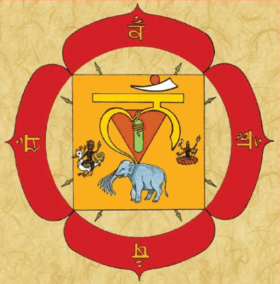

The visual representation of the Muladhara chakra is a lotus with four red petals.
As we have already seen, red is the color of passion. The basic adhara or root of life is to maintain continuity. The Muladhara is the adhara chakra and that is why the basic color is red. Red is also the color of the active force.
The four lotus petals are created by the vibrations of the four sounds — वं vaṃ, शं śaṃ, षं ṣaṃ, and सं saṃ — which gives rise to the four functions of apana vayu, which lies in the Muladhara.
We have seen that the apana function is an efferent function. That is, it moves from in to out. It is involved in the passing of urine, the passing of stools, ejaculation in males and menses in females. All these are natural ejaculation impulses.
In the visual of the Muladhara chakra, we see that each of the letters displays an anuswara or dot, which denotes the humming sound. This dot represents the potential to change the impulse from outgoing to inward-moving. That is, by humming the sound of the letters, you change its impulse from apana to prana. In other words, you take the letters back to their source in the Omkar.
On a physical level, this means getting rid of bodily waste. On a psychological level, the waste of negative emotions is to be transformed by consciously creating the prana impulse from the apana impulse. This control can come by practicing the Ashwini Mudra and the Vajroli Mudra.
But there is another way too, through mantra yoga. Each of the four sounds is labial, palatal, cerebral and dental. When we hum at the end of Omkar, we can manipulate the breath by using different areas of the mouth to bring about the same result as in the mudras.
The whole art is to allow the instinctive processes of the body to continue naturally on a physical level, but to transform them at a psychological level.
Within the red petals of the lotus, we see eight spears (shoola). They are called the weapons of Muladhara. Nature uses these weapons to keep man hypnotized and continue his progeny. They represent the eight directions of prana, that is, the eight subsidiary apana impulses. They are shaped like a woman’s breasts.
On a physical level, they give rise to eight reflex actions:
The four main apana impulses and eight subsidiary apana impulses are controlled by nadis. On a psychic level, we pause these impulses by consciously pinching the nadi and sending the current back up. This is done by awakening the Shakti of the Muladhara chakra called Dakini. By pinching the nadi, we change the direction of the current, that is an apana impulse becomes a prana impulse or an efferent impulse becomes an afferent impulse.
As we journey further into the lotus, we come upon the yellow square (pitta varna) of the earth element (prithvi). This is the element of the chakra. The eight spears emerge from this square of prithvi. That is, in their source they have a connection with the source of sound which lies in the muladhara chakra. However, in their present form, they are represented as spears, the kind that we use in language to hurt others. Again, these are mechanical apana impulses controlled by the subsidiary nadis and can be transformed in the same way. That is, our speech transforms and we are given the gift of ‘worshiping the Gods and Goddesses’ with beautiful words. So, by transforming these eight impulses we get the gift of beautiful speech.
We must understand the earth element as a vibration, a flow of current of a special kind. When this flow is balanced, it puts us in sympathy and harmony with our environment. When it is imbalanced, we try to rule over and rape nature.
When our feet press the earth, we receive the strongest and purest vibrations of this element. This is why we feel exhilaration when we venture out into the countryside.
The importance of the earth element helps us to better understand the healing properties of mud baths.
The color yellow in its dull form denotes all the waste material we throw out of the body. It also denotes the paleness of skin in diseases that appear when the earth vibrations are imbalanced, such as liver problems like jaundice.
Yellow is the color of the earth element in its perfected form. It is the force of the Sun or the solar current enshrined in the earth element. We do not see the color yellow when we look at the earth or even if we dig deep into it. But it is in certain flowers or fruits which carry the highest perfected vibration of the element. In metals, we see this color in gold, in fruits in the lemon, and in ripened grains. The yellow of mustard brings balance and harmony in our emotions. The bright yellow that emerges out of the Sun is called the culmination of light and is therefore a very precious color. That is why the most valuable foods are yellow in color. The liver is most favorably affected by eating yellow foods.
When we breathe in the scent of a yellow flower, we stimulate the nerves and bring direct nourishment to our souls. Yellow makes the flow of the currents of the earth element stronger and creates a powerful magnetism in our bodies.
I will continue the description of the chakra in the next article.